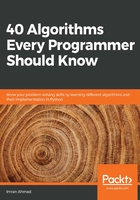
Selecting an algorithm
How do you know which one is a better solution? How do you know which algorithm runs faster? Time complexity and Big O notation (discussed later in this chapter) are really good tools for answering these types of questions.
To see where it can be useful, let's take a simple example where the objective is to sort a list of numbers. There are a couple of algorithms available that can do the job. The issue is how to choose the right one.
First, an observation that can be made is that if there are not too many numbers in the list, then it does not matter which algorithm do we choose to sort the list of numbers. So, if there are only 10 numbers in the list (n=10), then it does not matter which algorithm we choose as it would probably not take more than a few microseconds, even with a very badly designed algorithm. But as soon as the size of the list becomes 1 million, now the choice of the right algorithm will make a difference. A very badly written algorithm might even take a couple of hours to run, while a well-designed algorithm may finish sorting the list in a couple of seconds. So, for larger input datasets, it makes a lot of sense to invest time and effort, perform a performance analysis, and choose the correctly designed algorithm that will do the job required in an efficient manner.